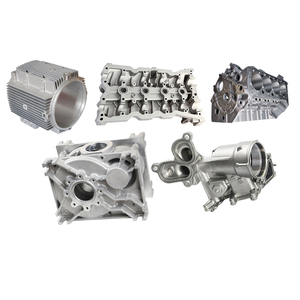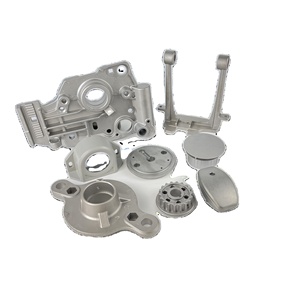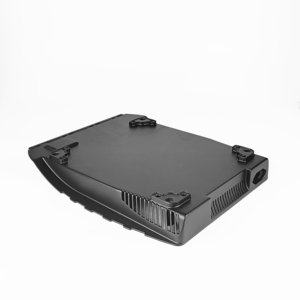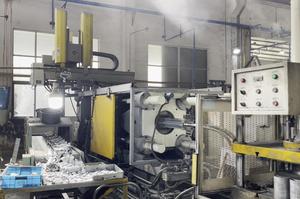
All categories
Featured selections
Trade Assurance
Buyer Central
Help Center
Get the app
Become a supplier

(484569 products available)














































Cast aluminum is a widely used material, especially in the manufacturing industry. Many buyers today look for cast aluminum parts.
Sand Casting
Sand casting is one of the most common and oldest casting process of aluminum. It is ideal for making small numbers of parts or for producing complex parts that are difficult to make using other methods. The casting sand molds are usually used only once, which makes this process adaptable for low-volume production. However, this means that more labor is used in the process, and the surfaces of the parts are not as smooth as those produced by other methods.
Die Casting
Die casting is used to get large quantities of cast aluminum parts that are normally used in cast aluminum patio furniture. Liquid aluminum is injected under high pressure into a steel mold or “die”. This process creates parts that are dimensional stable, with a good surface quality. There are two die casting processes, gravity die casting and low pressure die casting. High pressure die casting can be used to produce parts in large volume production.
Investment Casting (Lost Wax Casting)
In investment casting, a wax model is covered with a refractory material to create a mold. After that, the wax is melted and removed, leaving the mold into which the liquid aluminum is poured. Investment casting provides high dimensional accuracy and a good surface finish, suitable for detailed and complex parts. This process is often used in industries like aerospace and automotive.
Gravity Casting
In gravity casting, liquid aluminum is poured into a mold under the influence of gravity. This process is simple and cost-effective, particularly for producing medium to large parts. As a result, gravity casting is less expensive than high-pressure die casting.
Permanent Mold Casting
This casting works a lot like gravity and pressure die casting. A permanent mold is constructed out of steel, which is a reusable process. It involves pouring aluminum into a mold that is made of metal and usually steel, which is a reusable mold. This technique offers good repeatability and is generally applied in medium-volume productions.
Core Setting and Slush Casting
Core setting casting is usually used in making products with a hollow structure. In slush casting, the liquid metal is swirled inside the mold and then drained, leaving a thin layer of solidified metal. Slush casting is often used in producing light and decorative parts.
Cast aluminum allows to easily obtain complex shapes that cannot be achieved by simple machining of metals. Also, it can be used in making a wide range of products, from car engine components to kitchen utensils. Most of these products must have high strength and lightweight properties.
Cast aluminum alloy has a high strength and durability. Though it is much lighter than steel, aluminum still provides high strength. This makes aluminum ideal for use in industries that require heavy materials without the accompanying weight burden.
Also, this alloy has good corrosion resistance. Unlike steel, which easily rusts when exposed to water and oxygen, aluminum naturally forms a protective oxide layer on its surface. This barrier helps prevent corrosion.
In addition, cast aluminum is thermally conductive. This means that cast aluminum can efficiently transfer heat. Hence, it is often used in applications such as heat sinks and engine components, where effective heat dissipation is essential.
Another thing is that it is non-magnetic. This means it can be used in applications where magnetism must be avoided, as in certain electronic and medical equipment.
Lastly, cast aluminum is cost-effective compared to other metals. While pure aluminum may be somewhat expensive, cast aluminum is more affordable when compared to other options. This is due to its versatility and ease of production, making it a desirable choice in many industries.
Once buyers understand what cast aluminum is useful for, they can start exploring the product customization options available to them. These are the parts buyers should pay the most attention to in order to get the best customizations for their needs.
The surfaces of some cast aluminum parts can be treated to improve their appearance and functionality. These treatments include anodizing, painting, powder coating, or polishing. Each option has a unique benefit and may be required based on the environment the parts are going to be used in. For instance, anodizing improves corrosion resistance and electro-chemical bonding.
The cast aluminum can also be molded into unique shapes and sizes based on the purpose and requirements of specific projects. The casting process chosen determines the level of complexity in the design. Nevertheless, whether for functional use or aesthetic appeal, the shape and size can be tailored accordingly.
Aluminum casting parts can be customized to several dimensional tolerances based on the kind of project buyers are working on. In cases where precision is vital, fine tolerances can be established. For such purposes, investment or die casting would be the ideal options.
Buyers can also customize the alloy composition of the cast aluminum based on specific attributes. Some of the most common alloys include 380.0 alloy, 383.0 alloy, 413.0 alloy, C443.0 alloy, and A356.0 alloy. Each one offers unique features that can improve the performance of a cast aluminum product.
The mold traditional design in cast aluminum can also be customized. This allows for the creation of unique patterns, logos, or textures on the final product. For projects that need custom branding or specific design elements, mold customization offers an effective solution.
Additional operations such as machining, welding, or assembly can also be applied to cast aluminum products to meet specific project requirements. Buyers should always consider these options in order to get the final product that meets their desired specifications.
The below factors will help buyers ensure they purchase high-quality cast aluminum products, and avoid getting low-quality ones that are not useful, or worse detrimental to their health.
Various aluminum alloys have unique properties that make them useful for various uses. For instance, alloy 413 is known for its high strength and corrosion resistance. That makes it useful in areas with high levels of humidity. While the A380 alloy is often used for its fluidity and resistance to corrosion, the A356 alloy is ideal for components experiencing high fatigue levels.
These methods include sand casting, die casting, permanent mold casting, gravity casting, and lost wax casting. Each casting process has its advantages and disadvantages for various purposes. For example, die casting provides high precision and can be used for mass production, while sand casting is more adaptable for low-volume production.
Several surface treatments improve cast aluminum’s corrosion protection and aesthetic appeal. These treatments include anodizing, electroplating, powder coating, painting, and polishing.
Buyers should also note that anodizing offers corrosion protection while electroplating adds to the aluminum’s thickness for enhanced protection against corrosion. Normally, it involves applying a layer of chrome or nickel, which also adds to the aluminum's aesthetic appeal.
Some products like cast aluminum grill gates are meant for structural and industrial purposes. So they simply need to be strong. In such cases, cast aluminum should be a reasonable option. Other products like ornamental fences and furniture are used for aesthetic purposes. In such cases, buyers should get cast aluminum that has received cosmetic treatments.
Before placing bulk orders, buyers should first assess the quality of the cast aluminum products, as well as the manufacturing standards of the supplier. They should also ensure the industry standards are met to guarantee the durability, safety, and performance of the products.
Many manufacturers cast aluminum and use it in numerous industries. The automotive space reins, as cast aluminum is used to make engine blocks, transmission cases, wheels, and various parts that require high strength and low weight.
It is also a popular choice for the aerospace industry. Here it is used in making aircraft bodies and various other components. In the electronics realm, cast aluminum is used to make heat sinks and housing for devices.
Other places where cast aluminum is commonly used include construction, marine equipment, and even art.
While cast aluminum does not rust like steel, it can corrode under certain conditions. Hence, it is not entirely rust-free. Aluminum naturally forms an oxide layer that protects it from corrosion. This layer is often penetrated when aluminum is used in marine or chemical settings. To combat this problem, anodizing or applying a protective coating will further enhance aluminum’s corrosion resistance.
Alloy 380 is one of the most popular aluminum casting alloys used in die-casting applications. Its popularity can largely be attributed to its excellent fluidity, corrosion resistance, and mechanical properties. This alloy is ideal for parts that need to be highly detailed and complex. This is because it delivers good dimensional stability during the casting process.
That is not all, though. This alloy also has good thermal and electrical conductivity. Thus useful in automotive parts and electronic housings.
The most common defects usually occur during the casting process. They include porosity, surface defects, and dimensional inaccuracies.
Porosity is common when aluminum is not degassed appropriately before pouring. It results in gas bubbles being trapped within the metal. Moreover, if the aluminum cools too quickly during solidification, it results in shrinkage. It can also occur if there is no proper space for expansion.
Surface defects include marks, such as sand inclusions, skid marks, and scratches like burn and blistering. They occur due to the poor quality of materials, unprepared molds, or improper handling. Lastly, dimensional inaccuracies inhibit the achievement of the required tolerances. They result from insufficient die maintenance, thermal contraction, and inadequate crown allowance.